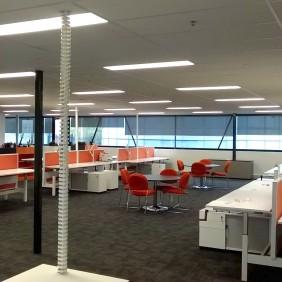When it comes to ergonomics in the workplace, there are a few things you need to keep in mind. First and foremost, ergonomics is the study of how people interact with their work environment. This includes everything from the design of your office space to the way you sit at your desk.
By making sure that your office is designed with your safety and comfort in mind, you can help to prevent injuries and improve your overall work performance.
What Is Workplace Ergonomics?
Workplace ergonomics is the study of how people interact with their work environment. The goal of workplace ergonomics is to reduce fatigue, discomfort, and injury by making sure that workstation design and equipment are suitable for the person using them.
fatigue, discomfort, and injury by making sure that workstation design and equipment are suitable for the person using them.
There are a few key elements to consider when it comes to workplace ergonomics, including:
- Posture
- Work surface
- Lighting
- Computer monitor height
- Keyboard and mouse position
All of these factors can play a role in how comfortable and safe you are while working. By making sure that your workspace is designed with ergonomics in mind, you can help to prevent injuries and improve your overall work performance.
There are a few key areas that you should focus on when it comes to ergonomics in the workplace.
First, take a look at your desk setup. Is your monitor at the correct height? Are you able to reach all of your necessary items without having to strain? If not, make some adjustments so that you can be as comfortable and productive as possible. In addition, pay attention to the way you sit in your chair.
Make sure that your back is properly supported and that your feet are able to touch the ground comfortably. Finally, take a look at your keyboard and mouse setup. Again, you want to be sure that you are not straining to reach these items. If necessary, invest in an ergonomic keyboard and mouse to help improve your comfort level.
What Are the Benefits of Workplace Ergonomics?
There are a number of benefits that come along with implementing workplace ergonomics. Let us take a look at some of the main benefits:
Improved Overall Comfort
The first and most obvious benefit of workplace ergonomics is that it can help to improve your overall comfort. By ensuring that your workspace is properly set up, you can avoid strain and discomfort. This, in turn, can help to improve your focus and concentration.
In addition, comfortable employees are generally happier employees. And happy employees tend to be more productive employees.
Reduced Risk of Injury
Another benefit of workplace ergonomics is that it can help to reduce the risk of injury. This is especially important if you work in an office environment where you are sitting for long periods of time. By making sure that your workspace is properly set up, you can help to avoid repetitive strain injuries.
In addition, by paying attention to your posture and ergonomic setup, you can help to avoid back pain and other musculoskeletal disorders.
Improved Work Performance
Finally, workplace ergonomics can also help to improve your overall work performance. This is because comfortable and healthy employees are generally more productive employees.
In addition, by reducing the risk of injury, you can help to ensure that you are able to work at your full potential.
Key Elements of Workplace Ergonomics
Now that we have looked at some of the main benefits of workplace ergonomics, let us take a look at some of the key elements.
These are the things you should focus on when setting up your workspace:
Ergonomic Chair
An important pieces of furniture in your office is your chair. Please make sure that your chair is comfortable and that it provides proper support for your back. In addition, you want to be sure that your chair is adjustable so that you can find the perfect position for your body.
support for your back. In addition, you want to be sure that your chair is adjustable so that you can find the perfect position for your body.
Ergonomic Desk
Another important piece of furniture in your office is your desk. Just as with your chair, you want to be sure that your desk is comfortable and that it provides proper support for your back. In addition, please make sure that your desk is the correct height for your body.
You should be sure that you have enough space to work comfortably. If your desk is too small or cluttered, it can make it difficult to focus on your work.
Ergonomic Keyboard and Mouse
Another important element of your workspace is your keyboard and mouse. You want to be sure that these items are positioned correctly so that you don’t have to strain to reach them. In addition, you want to be sure that your keyboard and mouse are the correct size for your hands.
If you find that you are constantly straining to reach your keyboard or mouse, you may want to consider investing in an ergonomic keyboard and mouse.
Proper Lighting
Another important element of your workspace is proper lighting. In addition, you want to be sure that the light is not too harsh or too dim.
If you find that the lighting in your office is not ideal, you may want to consider investing in an adjustable desk lamp.
No matter the type of office you have, following these simple ergonomic tips can help to improve your comfort, concentration, and productivity.
When it comes to office ergonomics, there is no one-size-fits-all solution. The best way to find the perfect setup for your needs is to experiment and find what works best for you.
Conclusion
As you can see, workplace ergonomics can provide a number of benefits for your business. By taking the time to set up your workspace correctly, you can help to improve the comfort, concentration, and productivity of your employees.
If you are looking for ways to improve the ergonomics of your office, be sure to check out our guide to the best ergonomic office chairs.
Thank you for reading! We hope this guide has been helpful. If you have any questions or comments, please don’t hesitate to reach out to us.









